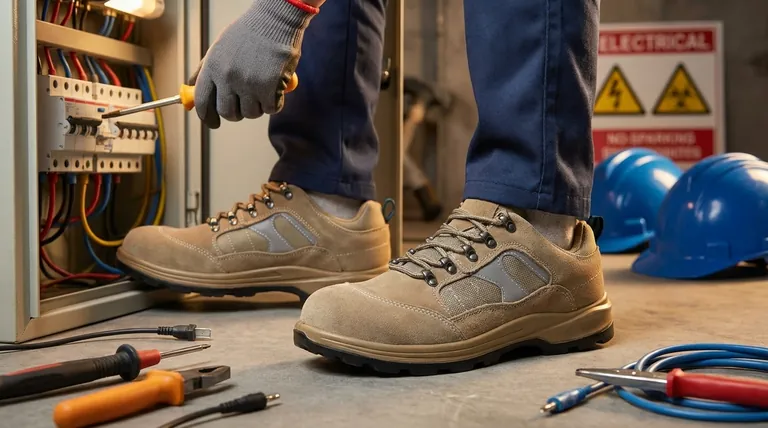At their core, composite-toe boots provide robust impact and compression protection using non-metallic materials like carbon fiber, Kevlar, or specialized plastics. They are engineered to meet or exceed the same official industry safety standards as steel-toe boots, but their primary safety advantages lie in their electrical and thermal properties.
The essential safety feature of a composite-toe boot is its ability to provide certified impact protection without using metal. This makes it uniquely suited for environments where electrical conductivity, temperature transfer, or metal detection are significant concerns.

The Anatomy of Composite-Toe Safety
Composite-toe boots are designed as a system where each component contributes to overall user safety. While the toe cap is the defining feature, it works in concert with other protective elements.
The Composite Toe Cap
The cap itself is the first line of defense. It's built from a blend of non-metallic materials, including carbon fiber, fiberglass, plastic, or Kevlar.
This construction delivers several key safety benefits that metal cannot offer.
Electrical Hazard Protection
Because they contain no metal, composite materials are non-conductive. This is a critical safety feature for electricians, engineers, and anyone working near live circuits, as it helps prevent the boot from completing an electrical path to the ground.
Superior Thermal Insulation
Metal is an excellent conductor of temperature, meaning steel-toe boots can become uncomfortably hot or dangerously cold in extreme weather. Composite materials do not transfer temperature readily, providing far better insulation and keeping the wearer's feet more comfortable and safe in demanding climates.
Non-Sparking Properties
In volatile environments where a single spark could be catastrophic, the non-metallic nature of composite-toe boots is a vital safety feature. They will not create a mechanical spark if struck against a hard surface, making them suitable for certain high-risk locations.
Beyond the Toe: Holistic Safety Features
A high-quality safety boot's protection extends well beyond the toe cap. These features are critical for comprehensive on-the-job safety.
Lighter Weight for Reduced Fatigue
Composite-toe boots are typically about 30% lighter than their steel-toe counterparts. While this sounds like a comfort feature, it is also a safety feature, as reduced weight leads to less fatigue over a long shift, which can help prevent trips, falls, and other accidents.
Puncture and Slip Resistance
Many safety boots, including composite-toe models, include a puncture-resistant midsole plate to protect against sharp objects from below. Furthermore, their outsoles are rated for slip resistance to ensure stable footing on wet or oily surfaces.
Metal-Free Environments
For workers in security, airports, or secure facilities, a completely metal-free boot is essential. Composite-toe construction allows for passing through metal detectors without issue, increasing efficiency and convenience without sacrificing protection.
Understanding the Trade-offs
No single piece of safety equipment is perfect for every situation. Objectivity requires acknowledging where composite-toe boots have limitations.
Impact Resistance After an Accident
While both steel and composite toes are rated to withstand the same initial impact and compression forces, they behave differently after a major incident. A composite toe that has sustained a critical impact may crack, compromising its integrity and requiring immediate replacement.
Bulk and Cost
To achieve the same safety rating as steel, a composite toe cap may need to be slightly bulkier. Additionally, while prices have become more competitive, composite-toe boots can sometimes be more expensive than comparable steel-toe models.
How to Apply This to Your Role
Your specific work environment is the ultimate guide to selecting the right boot.
- If your primary focus is electrical hazard protection: Composite-toe boots are the definitive choice due to their non-conductive properties.
- If your primary focus is working in extreme hot or cold weather: The thermal insulation of a composite toe provides a significant safety and comfort advantage.
- If your primary focus is passing through metal detectors frequently: A completely metal-free composite boot is the most practical and efficient option.
- If your primary focus is all-day comfort and minimizing fatigue: The significantly lighter weight of composite-toe boots can make a noticeable difference over long shifts.
Ultimately, choosing the right boot means matching its specific material advantages to the unique hazards and demands of your job.
Summary Table:
| Safety Feature | Key Benefit |
|---|---|
| Composite Toe Cap | Impact & compression protection without metal |
| Electrical Hazard Protection | Non-conductive for work near live circuits |
| Thermal Insulation | Resists temperature transfer in extreme climates |
| Non-Sparking | Safe for volatile environments |
| Lighter Weight | Reduces fatigue over long shifts |
| Puncture/Slip Resistance | Protects from sharp objects and slippery surfaces |
Need high-performance safety boots tailored to your specific work hazards?
As a large-scale manufacturer, 3515 produces a comprehensive range of composite-toe and other safety footwear for distributors, brand owners, and bulk clients. Our production capabilities encompass all types of protective shoes and boots, ensuring you get the exact combination of safety features, comfort, and durability your team requires.
Contact us today for a consultation and discover how we can equip your workforce with superior safety footwear.
Visual Guide

Related Products
- Wholesale Safety Boots Manufacturer for Custom & Private Label Orders
- High Performance Fire-Retardant Waterproof Safety Boots
- Wholesale Durable Safety Boots Manufacturer Customizable Steel Toe Work Boots
- Premium Wholesale Waterproof Safety Boots High Performance Protection for Industrial Markets
- Premium High-Cut Waterproof Safety Boots Manufacturing & Wholesale Solutions
People Also Ask
- What safety boots are recommended for the transportation industry? Find the Perfect Fit for Your Role
- What are the features of lace-up work boots? Achieve Maximum Safety and All-Day Comfort
- What does ASTM F2413-18 standard cover? Your Guide to U.S. Safety Toe Footwear Ratings
- What type of footwear is required for mechanics? The Ultimate Guide to Garage Safety Boots
- What advice is given for selecting the right boots? A Step-by-Step Guide to Finding Your Perfect Fit



















